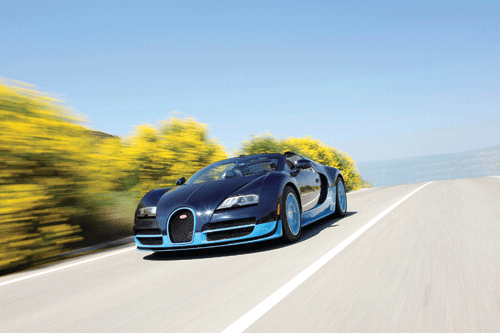The illuminated diodes blink up at me from their carbon-fiber dashboard encasement. Mileage. Speed. Performance. To one side sits the power gauge, its range like a prophecy carved in fiery letters: an impossible but unwavering 1,200 horsepower. As I take in the sleekness of the interior, the leather so supple it seems almost alive, the words “fastest production roadster in the world” flit through my head. I’m encased in a $2 million torpedo, and the top is down. Following the success of the 16.4 Super Sport, it didn’t take long for Bugatti to up its ante with a new addition to the Veyron line: an open-top version of the Super that could nevertheless deliver the Grand Sport’s power and speeds. The novelty alone was enough to set the fan forums buzzing — an open-top car capable of 410 kilometers an hour? The idea was like a gauntlet thrown in the face of physics. Tornadoes produce slower wind speeds. Strap a rocket to just about any other vehicle and set it off at 410 clicks and the air drag alone will, quite literally, rip it to pieces.
So why do it? Why tempt fate?
Why put a man on the moon, or a mechanical rover on the surface of Mars, for that matter? Any enterprise that pushes the bounds of the impossible contains its own implicit motivation, framed in the simple but central counter-question: why not?
Why not indeed, I think, and throw the car into first gear. The gas seems to drop to the floor of its own accord and the car is off, the world melting into indistinguishable streaks around it.
You can try to describe the Vitesse’s performance by such things as its horsepower or revolutions per minute, but personally, I find these stale calculations fall short of the car’s gut-wrenching reality. Going from zero to 100 in the space of a few heartbeats is best described, I think, as a kind of out-of-body experience. It’s as if the pure force of the vehicle’s takeoff has ripped the soul from your body and deposited it, confused and blinking, on the track behind you. It takes several seconds for your brain to catch up with the car, and when it does, it may still fail to comprehend the reality into which it’s been thrown. The world is a blur; the asphalt contracts beneath you like a snapped elastic band.
With this much power thrumming under your right foot, it’d be easy to panic — after all, unless you’re a professional Formula One driver, chances are this is the fastest you’ve ever moved at an elevation of four feet from the ground. But perhaps the most incredible and commendable thing about the Vitesse, once you’ve recovered from the initial G-Force of takeoff, is how straightforward the actual driving is. The gears slip smoothly upward, almost as an afterthought. Take your hands off the wheel and the car maintains a perfect, pencil-straight course forward. Turn it, and the vehicle prescribes neat, unflinching arks, its four-wheel traction solid as a rock. At every stage, the Vitesse seems to be working alongside you.
A device of both power and beauty
As with its performance, the Vitesse’s aesthetic does not overwhelm. Beautiful, to be sure: a number of aerodynamic measures carried over from the Super Sport, such as larger front-end air intakes and bottom air vents stretching sideways into the wheel house, transmit Bugatti’s characteristic mastery. Inside, the two-tone leather seats, carbon fiber console and quilted armrests, enhanced by contrasting stitching, do manage to convey a degree of luxury.
Every aspect of the vehicle is gorgeously worked, from its fine carbon weave to the buffed casements of its xenon headlights. But this is no high-shouldered Rolls Royce, no luxury sedan. There is nothing ostentatious in the design of this car, nothing to announce, to the untrained eye at least, its seven-figure price tag.
To see the car for what it truly is, you have to look below the hood (if there was one). The Vitesse’s Veyron W16 cylinder engine is a work of power and art, transferring nearly all the advantages of the Grand Sport in one neat package. With a maximum torque of 1,500 newton-meters, it boasts a maximum output of a staggering 1,200 horsepower (hp), achieved at 6,400 rotations per minute. Translate these figures into raw power and you’re looking at acceleration of zero to 100 kilometers an hour in just 2.6 seconds.
In the inner workings of the Vitesse, Bugatti seems to be hewing to the old Hot Rodder maxim: “More power, more better.”
Ettore Bugatti’s legacy
The car is purring away beneath me now, the world slipping by to reverberations of carbon fiber and steel. At speeds that would leave other roadsters spinning in the dust, the Vitesse seems only to be hitting its stride, rising smoothly through the instant shifts to well above 300 kilometers an hour. She’s topless and telling me, “Do what you want, I can take it!” The noise of the air rushing overhead is a torrential roar.
When you hear the Vitesse coming at you from a distance, the sound is like a stampede of mechanical bulls, reaching you long before the car actually swerves into view. It’s a darker, moodier sound than that of the original 1,000 hp Veyron engine. The 1,200 hp Vitesse engine employs bigger turbos, meaning less torque at low speeds and an extra jolt of power once it really starts to fly. I’m inside that sound now, and the roar pouring down from the corners of the windscreen is at once exhilarating and comforting.
I’ve just begun to relax into the car’s velocity when the radio beside me crackles — the signal to turn back. Regretfully, I release the gas pedal and press the brake. The car responds beautifully, relinquishing its speed with a steady, even pull.
The Vitesse is both beauty and the beast, a machine of aesthetic refinement with a dark side, capable of pushing the boundaries of both speed and sanity.
It could be months or years before Mercedes or Renault rolls out a car that can top the Vitesse in terms of speed. Until they do, Vitesse will remain the undisputed king of the roadsters — and by all indicators, it measures up to that lofty distinction.
NADIM MEHANNA is an automotive engineer and the pioneer of motoring on Middle Eastern television









